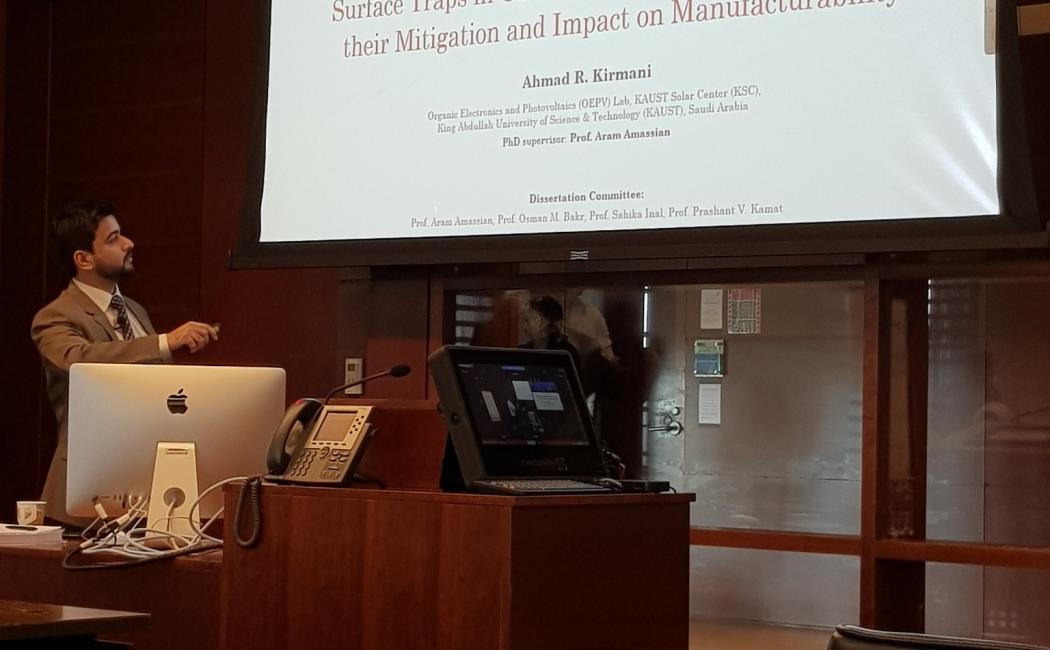
01 August, 2017
On July 31st KSC's Ahmad R. Kirmani successfully presented his research and defended his PhD thesis.
Regarding his time with KAUST Solar Center Ahmad commented, "I can very confidently say that I took a very good decision to choose KAUST as my PhD destination and the Amassian Lab as my venue."
Congratulations to Dr. Ahmad Kirmani and we wish him all the best for his continued career.
Surface Traps in Colloidal Quantum Dot Solar Cells, their Mitigation and Impact on Manufacturability
Ahmad R. Kirmani
Ph.D. Candidate supervised by Prof. Aram Amassian
ABSTRACT: Colloidal quantum dots (CQDs) are potentially low-cost, solution-processable semiconductors which are endowed, through their nanoscale dimensions, with strong absorption, band gap tunability, high dielectric constants and enhanced stability. CQDs are contenders as a standalone photovoltaics (PV) technology as well as a potential back layer for augmenting established PV technologies, such as Si. However, owing to their small size (ca. few nanometers), CQDs are prone to surface trap states that inhibit charge transport and threaten their otherwise wonderful optoelectronic properties. Surface traps have also, indirectly, impeded scalable and industry-compatible fabrication of these solar cells, as all of the reports, to date, have relied on spin-coating with sophisticated and tedious ligand exchange schemes, some of which need to be performed in low humidity environments. In this thesis, we posit that an in-depth understanding of the process-structure-property-performance relationship in CQDs can usher in fresh insights into the nature and origin of surface traps, lead to novel ways to mitigate them, and finally help achieve scalable fabrication. To this end, we probe the CQD surfaces and their interactions with process solvents, linkers, and ambient environment employing a suite of spectroscopic techniques.
Understanding CQD interactions with linkers and process solvents leads us to realize that methanol, the standard protic solvent for the legacy solid-state ligand exchange protocol, is the main culprit behind the need for materials wasting layer-by-layer solar cell fabrication recipe, as it interacts with and erodes the CQD surfaces over extended exposures, thereby necessitating fabrication of the absorber layer in several, short ligand exchange steps. We propose a modified exchange process involving an aprotic solvent, acetonitrile, which allows fabrication of CQD devices in much fewer steps, significantly curbing materials wastage and fabrication time without compromising device performance. Next, we suggest remote molecular doping of CQD solids as a novel, facile route to achieving controlled net doping and trap passivation. The applications of this doping strategy are demonstrated, first in the context of p-n heterojunction solar cells wherein the CQD absorber is p-doped, and next, for the n-i-p architectures wherein the CQD hole-transporter is p-doped, with clear device performance improvements. Finally, we overcome the two major challenges of manufacturability and scalability faced by CQD PV. As-prepared solar cells fabricated in high humidity ambient conditions are found to underperform, however, an oxygen-doping recipe is devised to mitigate the moisture-induced surface traps and recover the device performance. Importantly, these solar cells are fabricated at coating speeds of >15 m min-1 with roll-to-roll compatible techniques such as blade and bar coating requiring 1/25th the CQD material consumed by the standard spin-coated devices.
To sum up, this thesis develops an understanding of surface traps in the context of CQD solar cells and demonstrates efficient protocols to mitigate them, such as solvent engineering, remote molecular doping and oxygen doping. Our efforts finally culminate in the realization of robust, ambient-manufactured, scalable and efficient CQD solar cells.